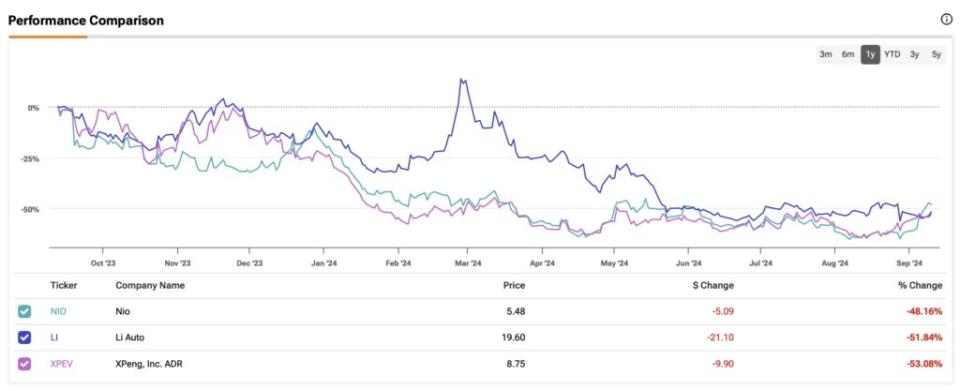NIO, LI, or XPEV: Which Chinese EV Maker Is the Best Pick?

The Chinese electric vehicle (EV) market has grown rapidly, becoming the largest in the world. However, this growth has led to fierce competition, which has pressured margins and stock prices of major players. In this article, using the TipRanks Stock Comparison tool, I’ll explain why I rate Li Auto (LI) as a Buy and view it as a better investment than Nio (NIO) and XPeng (XPEV), which I rate Hold and Sell, respectively.
Nio (NIO)
My Hold rating on Nio stems from the company’s consistent quarterly losses, driven by intense competition in the EV sector. As a prominent player in the premium Chinese EV market, Nio is recognized for its high-end electric SUVs and innovative battery-swapping system. However, Nio holds just 2.1% of the domestic market share in China. This limited market presence may hinder the company’s path to sustained profitability and effective scaling.
For Q2 2024, Nio reported an adjusted net loss of RMB 4.535 billion (around $624.1 million). This was a 16.7% decrease from the previous year. Recent delivery data is more encouraging. From January to August of this year, Nio delivered 128,100 vehicles, representing a 35.8% yearly increase. This performance helped regain investor confidence, as evidenced by a prolonged rally in the company’s shares, which rose over 14% following the Q2 results.
NIO’s Valuation, Momentum, and Wall Street Consensus
Nio’s valuation shows a price-to-sales (P/S) ratio of nearly 1.2x, above the industry average, but suggests some de-risking. However, this does not necessarily indicate a Buy signal. The primary concern is the price-to-book (P/B) ratio of 5.1x, which is much higher than its Chinese peers, given its asset base.
In terms of momentum, the stock has surged nearly 50% since late August of this year. Nonetheless, technical indicators, such as an RSI of 76.27, suggest that the stock might be overbought. Despite this, Nio’s share price remains above both the short-term and long-term moving averages, which signals a continued bullish trend.
Additionally, Wall Street’s consensus on NIO is a Moderate Buy, with six of eleven analysts bullish, four neutral, and one bearish. The average price target is $5.97, implying potential upside of 8.84%.
Li Auto (LI)
I am most bullish on Li Auto due to the company’s superior margins compared to other Chinese EV manufacturers. Li Auto stands out in the Chinese EV market for its extended-range vehicles that combine electric power with a small gasoline engine.
In its most recent quarter (Q2 2024), Li Auto achieved a vehicle margin of 18.7%. Although this represents a decline from 21% in the same quarter of 2023, it remains the highest margin among its peers. For comparison, Nio reported a vehicle margin of 12.2%, while XPeng had a margin of 6.4% in its most recent quarter.
Despite the drop in margins—reflecting the competitive nature of the EV market—Li Auto remained profitable in Q2, reporting gross profits at RMB 6.2 billion (approximately $850 million), a 16.9% increase compared to Q1. This performance positions Li Auto as one of the lower-risk investment options within its segment.
LI’s Valuation, Momentum, and Wall Street Consensus
Another factor in my bullish outlook on Li Auto is its valuation. Despite its profitability and strong margins, Li Auto is one of the most attractively valued EV companies in its sector. It trades at a P/S ratio of 1.1x. Additionally, its P/B ratio is 2.3x, which is less than half of Nio’s but higher than XPeng’s.
Regarding technical indicators, with the share price being down 53% over the past twelve months, Li Auto’s stock trades below its 100-day moving average, which is $21.28. This suggests that the stock might be in a recovery phase or attempting to stabilize after a prolonged bearish period.
Moreover, Wall Street’s consensus is largely bullish, with a Moderate Buy rating. Six out of nine analysts recommend a buy, and the average price target is $26.82, suggesting upside potential of 38.14%.
XPeng (XPEV)
Lastly, I remain bearish on XPeng stock due to its persistent execution issues and poor margins, making it the least favorable of the trio. XPeng is known for its focus on smart, connected, and affordable EVs, emphasizing technology and innovation in autonomous driving.
XPeng significantly lags behind Nio and Li Auto in vehicle margins at 6.4% and faces a bleak Q3 delivery outlook, with only 12.5% year-over-year growth projected. Much of this growth depends on the sales of its new Mona M03, priced from less than $17,000. Although the company has already received over 10,000 non-refundable orders for the vehicle, there is uncertainty about whether it can meet its delivery numbers each month. Additionally, profitability remains in question if actual deliveries fall short of expectations.
XPEV’s Valuation, Momentum, and Wall Street Consensus
Contributing to my bearish outlook, I find it perplexing that XPeng, despite having lower vehicle margins compared to its peers, trades at a P/S ratio of 1.6x—higher than both Nio and Li Auto. While its P/B ratio of 1.7x is lower than its peers, this may reflect concerns about the company’s financial health. With $5.14 billion in cash and equivalents and other near-cash assets (ended June 30, 2024), XPeng could face financial strain, as analysts do not expect profitability until at least 2026.
On the positive side, XPeng’s stock trades below its 200-day moving average but above shorter-term averages. This suggests short-term bullish momentum within a broader bearish trend, possibly signaling market indecision.
Contrary to my pessimistic view, analysts’ consensus is bullish on XPeng’s stock. It holds a “Moderate Buy” rating, with seven out of ten analysts recommending a Buy. The average price target is $11.55, suggesting potential upside of 26.51%.
Conclusion: LI Auto Is My Top Pick
Investing in Chinese EV stocks has been risky, with several headwinds driving industry-wide selloffs. Among the players, I view Li Auto stock as the least risky and rate it a Buy, thanks to its reasonable valuation and strong margins. In contrast, Nio’s profitability challenges warrant a cautious outlook, while XPeng’s low margins support a bearish stance.
Breaking news
See all






